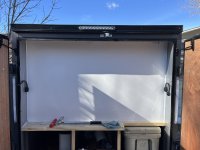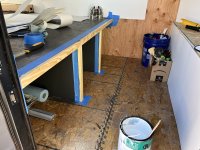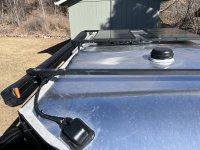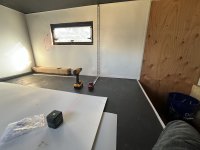Jmanscotch
is wandering
Aimed to get over a hump this weekend by putting the paneling up inside, but snow and a sick daughter kept that from happening..soon though.

Instead, I worked on a few smaller projects during her nap times. As the snow started to fall, I started fitting the solar panel mounts.
I bought two EcoFlow 100W all black panels. I was going to go for some Renogy units like last time, but these EcoFlows were nearly the same price and featured the black frame, which I though was a nice touch over the traditional aluminum…not that you’ll see it really.
Used 1” angle iron to span between the rear two roof rack cross bars. Simply clamped them in place, drilled a 1/4” hole through the cross bars and angle iron and bolted them down. Tech tip, put a piece of wood under where you’re drilling so you don’t accidentally pierce through the roof when the drill bill punches out the bottom side of the mounts.

Panels sit directly onto the angle iron and bolt down. I though this was going to be the cleanest install, and it is, but there’s two things that make me wish I had done it slightly differently:
- it was a chore to drill the panel mounting holes in the right spot and then get all the hardware installed to bolt them down. Tight and blind spots to get to.
- I think the small crevice between the edge of the panel and the angle iron is going to collect water/snow/dirt and that’s not ideal.


The freezing rain had my hands wet and cold and I forgot to take a final picture of the second panel on. Still need to hook up all the wiring, but the cold and snow meant that’ll have to wait.
I opted to do an inside project next, cut the holes for the upper and lower cabinets.


Uppers will have either doors over them (because my jigsaw cutting ability sucks and the cuts are too wavy to display) or nets that hold gear inside.
Lower cabinet/bench needed a quick access panel for the main power switch and seeing the status of the battery and such.
Opted to go with a premade marine grade door with trickier latch (relative) as my daughter loves to mess with doors, knobs and such and she would’ve always been getting into a basic hinged door panel and probably turning off the power switch to the camper…so this will maybe help keep her out a bit while she’s in this “open everything and turn every switch” phase.


Sat back and relaxed a bit, before getting back to the kiddo. Starting to feel like a camper now.


Instead, I worked on a few smaller projects during her nap times. As the snow started to fall, I started fitting the solar panel mounts.
I bought two EcoFlow 100W all black panels. I was going to go for some Renogy units like last time, but these EcoFlows were nearly the same price and featured the black frame, which I though was a nice touch over the traditional aluminum…not that you’ll see it really.
Used 1” angle iron to span between the rear two roof rack cross bars. Simply clamped them in place, drilled a 1/4” hole through the cross bars and angle iron and bolted them down. Tech tip, put a piece of wood under where you’re drilling so you don’t accidentally pierce through the roof when the drill bill punches out the bottom side of the mounts.

Panels sit directly onto the angle iron and bolt down. I though this was going to be the cleanest install, and it is, but there’s two things that make me wish I had done it slightly differently:
- it was a chore to drill the panel mounting holes in the right spot and then get all the hardware installed to bolt them down. Tight and blind spots to get to.
- I think the small crevice between the edge of the panel and the angle iron is going to collect water/snow/dirt and that’s not ideal.


The freezing rain had my hands wet and cold and I forgot to take a final picture of the second panel on. Still need to hook up all the wiring, but the cold and snow meant that’ll have to wait.
I opted to do an inside project next, cut the holes for the upper and lower cabinets.


Uppers will have either doors over them (because my jigsaw cutting ability sucks and the cuts are too wavy to display) or nets that hold gear inside.
Lower cabinet/bench needed a quick access panel for the main power switch and seeing the status of the battery and such.
Opted to go with a premade marine grade door with trickier latch (relative) as my daughter loves to mess with doors, knobs and such and she would’ve always been getting into a basic hinged door panel and probably turning off the power switch to the camper…so this will maybe help keep her out a bit while she’s in this “open everything and turn every switch” phase.


Sat back and relaxed a bit, before getting back to the kiddo. Starting to feel like a camper now.
























